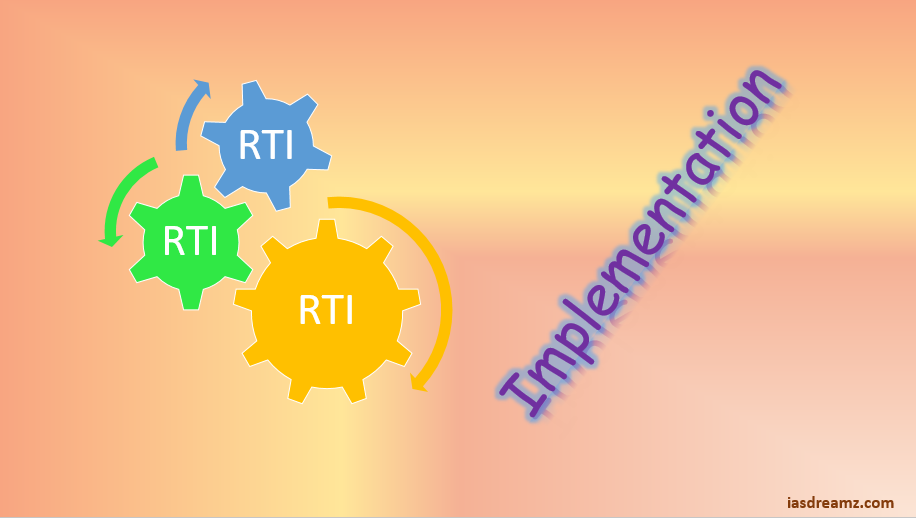The Implementation of RTI Act is divided into four articles for the sake of convenience of the students in understanding it step by step. In this article we will take up the topic of Implementation of RTI Act Building Institutions.
The below are the Rights and Obligations under the RTI Act:
I. BUILDING INSTITUTIONS: (We are here)
- Information Commissions
- Information Officers and Appellate Authorities.
II. INFORMATION AND RECORD-KEEPING:
- Suo motu declaration.
- Public Interest Disclosure.
- Modernizing recordkeeping.
III. CAPACITY BUILDING AND AWARENESS GENERATION:
IV. CREATION OF MONITORING MECHANISMS.

RTI Act Building Institutions
Information Commissions
Government of India (GOI) constituted the Central Information Commission (CIC) with a Chief Information Commissioner and four Information Commissioners (Section 12).
The CIC has been hearing appeals under the Act.
The provisions of Section 15 came into force at once, thereby meaning that all the State Governments were required to constitute their respective Commissions immediately on enactment of the RTI Act.
The Commission also obtained information about the background of the State Chief Information Commissioners so as to ascertain whether all sections of society are being represented.
The Act provides for selection of CIC and SICs in a bipartisan manner, and involves the Leader of the Opposition in the process.
Since the Act is applicable to all three organs of the State, it would be appropriate to include in the selection committee the Chief Justice of the Supreme Court or High Court as the case may be.
This will inspire public confidence and enhance the quality of the selection.
Act allows for dispersal of Information Commissions to provide easy access to citizens. {Section 12(7), 15(7)}.
However, neither the CIC nor the SICs have established offices at places other than the Capitals.
For an overly citizen friendly law to be effectively implemented, it is vital to have easy access in a vast country like ours.
The Commission is therefore of the view that the CIC should be dispersed in atleast 4 regions.
Similarly, the SICs in larger States should be dispersed depending on population density and geographical area.
Act visualizes a Commission wherein the Members represent different sections of the society.
The State Governments are still in the process of appointing Information Commissioners. But an analysis of the background of the State Chief Information Commissioners indicates the preponderance of persons with civil service background.
Members with civil services background no doubt bring with them wide experience and an intricate knowledge of government functioning. However, to inspire public confidence and in the light of the provisions of the Act, it is desirable that the Commissions have a large proportion of members with non-civil services background.
Recommendations:
(i)Section 12 of the Act may be amended to constitute the Selection Committee of CIC with the Prime Minister, Leader of the Opposition and the Chief Justice of India. Section 15 may be similarly amended to constitute the Selection Committee at the State level with the Chief Minister, Leader of the Opposition and the Chief Justice of the High Court.
(ii)The GOI should ensure the constitution of SICs in all States within 3 months.
(iii)The CIC should establish 4 regional offices of CIC with a Commissioner heading each. Similarly, regional offices of SICs should be established in larger States.
(iv)At least half of the members of the Information Commissions should be drawn from non-civil services background. Such a provision may be made in the Rules under the Act, by the Union Government, applicable to both CIC and SICs.
Designating Information Officers and Appellate Authorities:
All Union Ministries/Departments have designated PIOs thus complying with the stipulation of designating PIOs.
Commission also noted that in GOI the level of PIOs varied from Joint Secretary to Under Secretary.
Ideally the PIO should be of a sufficiently senior rank. This is done to enable them to access information and furnish it in an intelligible and useful manner.
At the same time the PIO should be sufficiently accessible to the public.
Therefore, the Commission is of the view that in GOI there should be a uniform pattern of appointing an officer of the rank of Deputy Secretary/Director as PIO.
While Section 19(1) read with Section 7(3) (b) implies designating an appellate authority for each PIO. The law does not specifically provide for designating of appellate authorities as it does in case of PIOs.
While PIOs are invariably notified, this is not the case with appellate authorities. This omission needs to be rectified.
Recommendations:
(i) All Ministries/ Departments/Agencies/Offices with more than one PIO have to designate a nodal Assistant Public Information Officer with the authority to receive requests for information on behalf of all PIOs. Such a provision should be incorporated in the Rules by appropriate governments.
(ii) PIOs in Central Secretariats should be of the level of atleast Deputy Secretary /Director. In State Secretariats, officers of similar rank should be notified as PIOs. In all subordinate agencies and departments, officers sufficiently senior in rank and yet accessible to public may be designated as PIOs.
(iii) All public authorities may be advised by the Government of India that along with the Public Information Officers they should also designate the appellate authority and publish both, together.
(iv) The designation and notification of Appellate Authorities for each public authority may be made either under Rules or by invoking Section 30 of the Act.
References:
